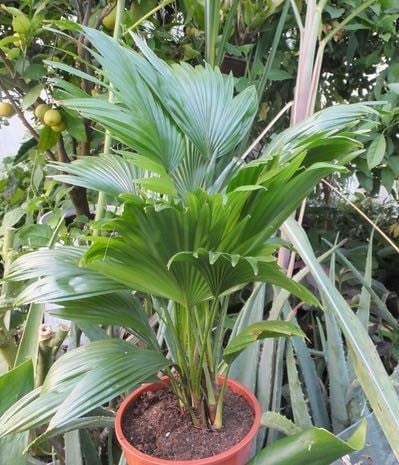
Fan palms, Livistona chinensis & L. rotundifolia, are tough enduring specimens for frost free greenhouses, conservatories or even as house plants. These endure considerable neglect yet make highly decorative foliage displays year round. Although flowering and even fruiting does happen this occurs when mature- by which time these could be 30 feet for the chinensis or twice that at 60 feet tall for the Indonesian species rotundifolia!
Don’t worry though, these are slow growing and remain neat and compact for decades, especially kept a tad pot-bound. (Their pot or tub needs be terracotta for as the head fills out this makes the plant rather top heavy and prone to blowing over. Also use heavy, rich, soil or sand based compost for the extra mass.)
Although suitable in shade or sun be careful not to move from the former to the latter without some temporary shading as it’s easy to scorch the beautiful leaves. These benefit from a light misting and wiping over with a damp cloth every few weeks to remove dust and debris that tends to accumulate otherwise. Likewise providing you harden these off first they can move out onto the patio for the summer.
As these are true species Livistona can be grown from seed however this is a slow process so I suggest you start with plants, even large ones if you want instant impact.
These are very obliging plants and unless severely dried off usually recover. It’s better to water lightly and regularly though! Use rainwater, preferably warmed, as tap water may cause the tips of the leaves to go brown.
Other than mealy bugs and sometimes red spider mite these are seldom bothered by pests and suffer few diseases. Do not water-log though as the roots may rot. And be careful when handling young stems as these carry many little barbs.
For the connoisseur there’s a half dozen or so species including L. saribus the Noble Sugar Palm of the Far East and an Australian relative, L. australe, the Gippsland Cabbage Palm, which has leaves that can be eaten as cabbage when young and tender, um, yum yum.
Oh yes, the name, it is Livistona not Livingston though named after the Baron of Livingston a 17th century botanist who’s collection became Edinburgh Botanic Garden.


